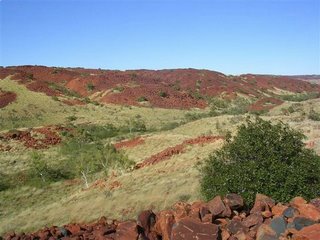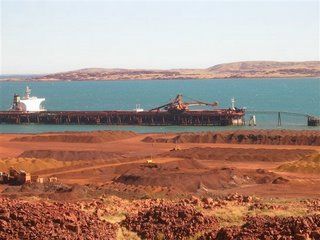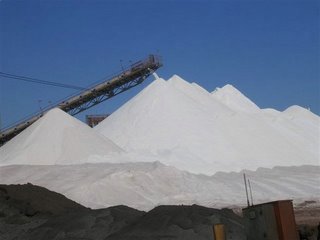With acknowledgment to John Willamson

Jumbled piles of dolerite characterise the hills around Dampier
Yet, these jumbles of rocks must have represented different things to different people? To the road-builder, township developer or investors in the port facilities at Dampier the boulder strewn environment must have been a huge impediment to development. However, 5 - 6000 years ago the Aboriginals that frequented the Burrup peninsula regarded them as a perfect medium for recording the things they saw around them by engraving the face of the rocks. In the process they left behind what is considered to be the largest outdoor art gallery in Australia! We visited “Deep Gorge” on the Burrup peninsula in order to see the Aboriginal engravings.

They were not all that easy to find amongst the profusion of boulders. Many rather indistinct, but we discovered that by climbing to the top of the ridges and looking downwards, the etchings became easier to locate. We were also pleased to see some wallaroos (euros) boulder hopping amongst the jumble of rocks, one stopping on the skyline to watch us, before disappearing over the rim.
The conducted tour we took of Rio Tinto’s (Hamersley Iron) port facility, built in 1966 and now Australia’s largest tonnage port shipping 65 million tons of iron ore each year to countries all over the world, proved very worthwhile. It began with a 20 min video before boarding a bus that took us to see and hear a mass of facts come spinning out according to what our eyes beheld….Each train capable of carrying 25 000 tons of ore from the mines inland, the machinery used to unload the 2.4km long trains; each ore wagon being unloaded in 60 seconds; the loading of the 250 000 ton ships waiting at the terminals; driving alongside the conveyor, itself 5km long and running at a speed of 25km/hr, carrying the ore out to the stockpiles on East Intercourse Island; the trouble taken to suppress dust emissions, a vacuum cleaner (the size of a three storey building to help see to the job); a massive stockpile of 44 gallon drums in which samples of the ore being shipped are retained just in case there is any argument about the quality!

Even the stockpile colours of ore differ according to each of the seven mines in the Pilbara. These may be blended together for consistency and, there was a site for the blenders to practise this art. We were equally surprised to learn that the Queen of England was the single largest shareholder in Rio Tinto – the crafty old devil!!
Our blog had us on a wild goose chase this week! All on schedule first thing Monday morning to send it off – we found the only internet café was closed for 50th birthday celebrations! Their notice advised the used of the town library. Not possible - in turn, they suggested Macdonalds… even the Seafarers Centre in Dampier gave us hope but all were to no avail. We had to wait until Thursday for the original café to open up - only it didn’t! Fortunately a painter advised us of a dive shop with internet access in the next block BUT we found it round another … this poorly advertised place was perfect and so well set up that we finally had last week’s blog on its way. As a result it will throw this week’s one out as well – sorry!
Internet work completed, we left Karratha, heading north with plans to visit the ghost town of Cossack and spend a night in Port Samson. Cossack was once the first port in the North West, home to the fast growing mother of pearl industry. However, after being obliterated by several cyclones in the 1890’s, the establishment of a harbour & jetty at Port Samson and over-exploitation of the pearling grounds, Cossack was abandoned in 1950. Beautifully reconstructed, one of the old buildings house backpackers and another is used by local Aboriginals as an art centre. The Cossack Art Award is staged annually in this historic settlement. Respected internationally and recognised nationally as the most isolated acquisitive art exhibition in the world. And, we struck lucky with the dates and were able to walk through the Old Bond Store enjoying this colossal exhibition in the middle of nowhere. Particularly, the Pilbara subject matter in assorted mediums.
No sites available in Port Samson so we took to the bush finding a small rest area beside the West Peawah river on route for Port Hedland. Parked 25m away we noticed a man, slumped in the front seat of his car, apparently sleeping. Feeling sorry for him Lea even suggested we should invite him to supper. However, later that evening with our game of scrabble over Lea & Paula were quietly rolling up the extension cord with the aid of a torch when the silence of the night was broken by horrendous cussing & swearing as this fellow leapt out of his car directing his wrath at them. In horror, they scuttled into the caravan and after the nervous giggling subsided Paula crept out to her “boudoir” in Skiv – locking all doors for the first time! Nerves on edge – we all twitched at every sound until the crazy fiend drove off far too fast for the gear. The empty beer cans in the morning gave good reason!
Arriving in Port Hedland, we chose to inform ourselves about BHP Billiton’s similarly massive investment in the mining and export of iron ore. They claim to hold the world record for the operation of large trains – one, in 2001, had 682 wagons, stretching 7.3 kms, carrying 99,732 tonnes! The port even contains an under sea bed harbour tunnel for the delivery of iron ore fines to an island offshore. On the edge of the town was a large expanse of evaporation ponds used for the production of salt and one of our lasting memories of the place will be the masses of road trains carrying ore, salt, and fuel on the approach roads.

Dampier Salt's stockpile at Port Hedland
Thus, with our “oresome” experiences for the week over and leaving what must be one of Western Australia’s most highly modified, industrial regions this Saturday morning - it is a welcome relief to now be writing this on the edge of the de Grey river in a large rest area dominated by huge paper-barks, river gums and plenty of bird-life. So good, that when we stopped for morning tea decided we had to linger longer ….
No comments:
Post a Comment